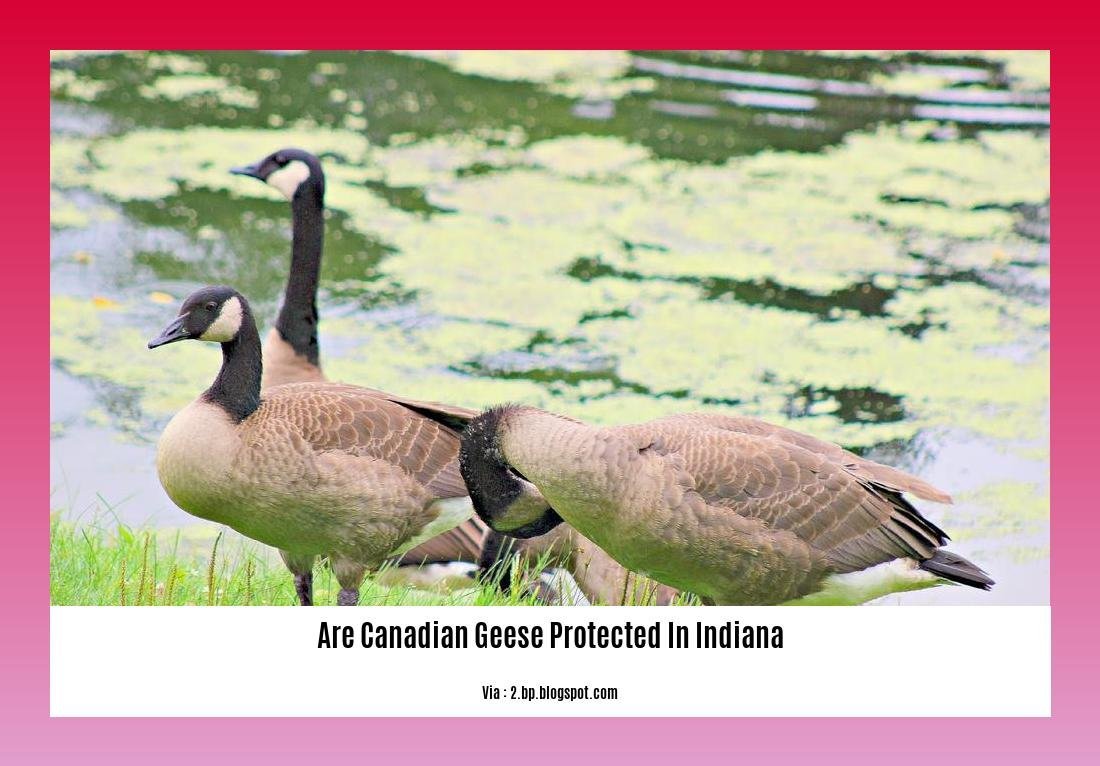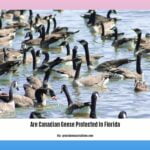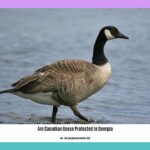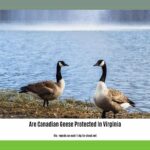Understanding the Legal Protection: Are Canadian Geese Protected in Indiana?
In the dynamic realm of wildlife conservation, it is crucial to unravel the legal protection surrounding various avian species to ensure their ongoing preservation. This article dives into the fascinating world of Canadian geese and their status in the state of Indiana. As these magnificent creatures gracefully traverse the skies, we delve into the question of their protection, shedding light on the legal framework governing their existence within this region. Join us on this journey to comprehend the significance of Canadian geese and our collective responsibility in harmoniously co-existing with them.
Key Takeaways:
- Canada geese are protected in Indiana under the Migratory Bird Treaty Act of 1918.
- It is illegal to harm geese under the Migratory Bird Treaty Act of 1918.
- Only those with a state-issued special license are permitted to shoot geese during the hunting season in Indiana.
- Permits are available to shoot depredating Canada geese outside of the normal hunting season.
- Domestic geese are not regulated by the Indiana Department of Natural Resources.
- Hitting a goose with a car is illegal and considered a serious offense in Indiana.
- Canada geese have become common in Indiana due to restoration efforts and an increase in small urban and suburban water bodies.
- The Indiana Division of Fish & Wildlife may issue permits for agricultural depredation and trapping activities concerning Canada geese.
- Shooting hours for geese and ducks in Indiana are from one-half hour before sunrise to sunset, except for teal season.
- Canada goose management aims to reduce conflicts rather than eliminating all geese.
Are Canadian Geese Protected in Indiana?
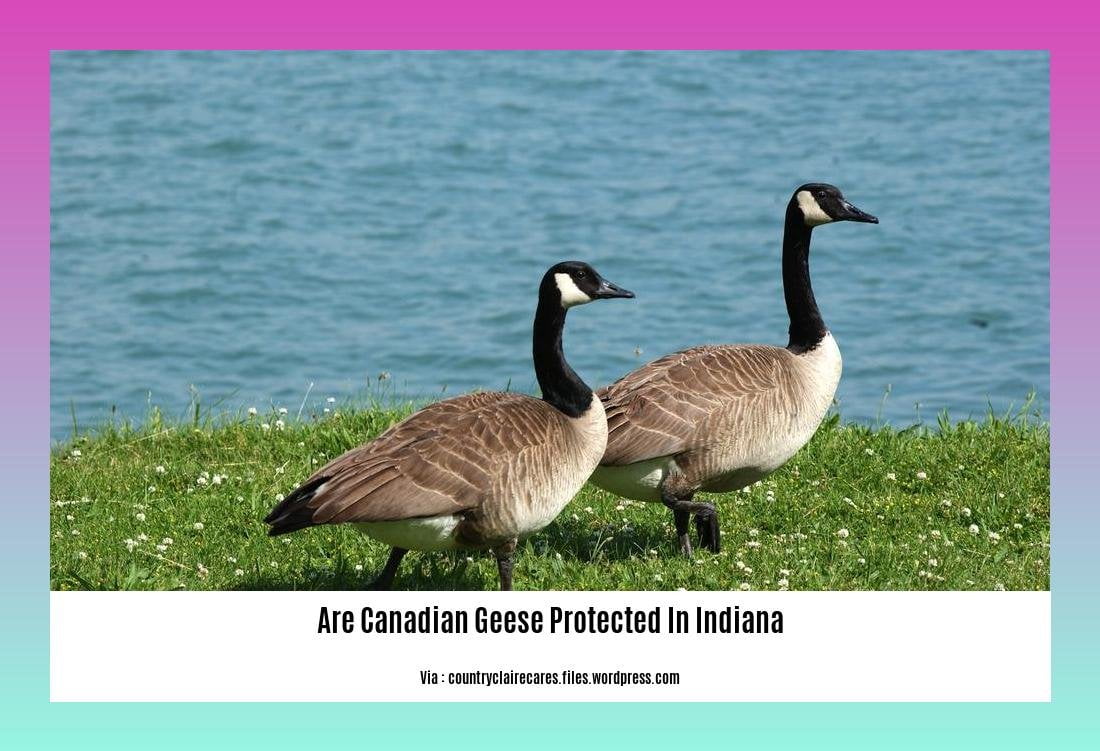
As wildlife enthusiasts and nature lovers, it’s essential for us to understand the legal protection extended to the Canadian geese in Indiana. These magnificent creatures play a crucial role in the delicate balance of our ecosystems. In this article, we will explore the regulations surrounding the protection of Canadian geese in Indiana and the responsibilities we have as individuals to coexist with them in harmony.
The Migratory Bird Treaty Act of 1918
Under the Migratory Bird Treaty Act of 1918, Canadian geese are protected in Indiana. It is illegal to harm these geese or their nests and eggs. This act is in place to ensure the conservation of migratory birds, including the Canadian geese, and to maintain their populations for future generations to enjoy.
Hunting Regulations
During the hunting season in Indiana, individuals must have a valid state-issued special license to hunt geese. This helps regulate and control hunting activities to ensure sustainable populations of Canadian geese. However, outside of the hunting season, permits may be available to shoot depredating geese that pose a threat to agricultural areas.
Wildlife Conservation Efforts
The Indiana Division of Fish & Wildlife plays a crucial role in the conservation and management of Canadian geese. They issue permits for agricultural depredation and trapping activities concerning Canada geese. These measures aim to minimize conflicts between geese and humans while promoting a healthy coexistence.
Geese in Urban and Suburban Areas
Due to restoration efforts and the increase in small urban and suburban waterbodies, Canadian geese have become quite common in Indiana. These areas provide suitable habitats for geese to nest and thrive. It’s important to remember that even though they may become accustomed to human presence, they still require protection and respect.
Individuals’ Responsibilities
As individuals, we have responsibilities when it comes to coexisting with Canadian geese. Hitting a goose with a car is not only dangerous but also illegal in Indiana. It is considered a serious offense due to the potential harm it can cause to both the goose and humans.
By understanding the regulations in place to protect Canadian geese and maintaining a respectful coexistence, we can ensure the conservation of these beautiful birds. Let us appreciate their ecological significance and contribute to the preservation of their populations for generations to come.
Are backyard fires allowed in Calgary? Find out the regulations and guidelines for backyard fires in Calgary by clicking here.
Are Canadian geese protected in Florida? Discover the legal status and protection measures for Canadian geese in Florida by visiting this link.
Curious about the protection of Canadian geese in Georgia? Click here to learn more about the regulations and conservation efforts in place.
Find out about the protection status of Canadian geese in Virginia and the measures taken to ensure their conservation by clicking here.
Discussion on the Breeding and Nesting Habits of Canadian Geese
The breeding and nesting habits of Canadian geese are fascinating and play a crucial role in the survival and conservation of these magnificent creatures. Understanding their behavior and reproductive patterns can provide valuable insights into their ecological significance and the responsibilities we have in co-existing with them in harmony.
Breeding Season and Nesting Location
Canadian geese living in latitudes further north delay breeding until May or June. During this time, they search for suitable nesting locations to raise their young. These geese nest on or near the edges of wetlands or on small islands, often returning to the same nesting sites every year. The choice of location is critical for the safety and well-being of the goslings, as the wetlands provide protection from predators.
Nest Construction and Egg Laying
The process of nest construction is primarily the responsibility of the female Canada goose. The male remains nearby, providing support and maintaining vigilance. The nests are constructed from vegetation, forming raised mounds near the water’s edge and taking on a bowl shape. These nests are large enough to support the brooding female and provide a safe space for incubating the eggs.
A typical clutch laid by a Canada goose consists of between 2 to 18 eggs. These eggs are approximately 5.6 cm (2.2 in) wide and 8.3 cm (3.3 in) long. The female goose diligently incubates the eggs, ensuring they remain warm until hatching. This incubation period usually lasts around 25 to 30 days, during which the female rarely leaves the nest and relies on the male to bring her food.
Cooperative Behavior and Monogamy
Canada geese display high levels of cooperation when it comes to locating food sources, building nests, and protecting their young. They work together as a team, displaying social behaviors with other flocks while migrating. The bond between the male and female Canada geese is often long-lasting, and they may mate for life. If one of the pair dies, the surviving goose may eventually find another mate.
Key Takeaways:
- Canadian geese delay breeding until May or June, and they nest on or near the edges of wetlands or small islands.
- The female goose constructs the nest alone while the male provides support and remains vigilant.
- Canada goose nests are raised mounds near water, formed from vegetation and taking on a bowl shape.
- A typical clutch laid by a Canada goose consists of between 2 to 18 eggs, which are incubated by the female for approximately 25 to 30 days.
- Canada geese display high levels of cooperation with each other while locating food sources, building nests, and protecting their young.
- These geese often mate for life, and if one of the pair dies, the surviving goose may find another mate.
Sources:
– Birdfact: Canada Goose Nesting
– Animal Behavior Corner: Canada Goose Behavior
Exploration of the Responsibilities of Individuals in Co-existing with Canadian Geese
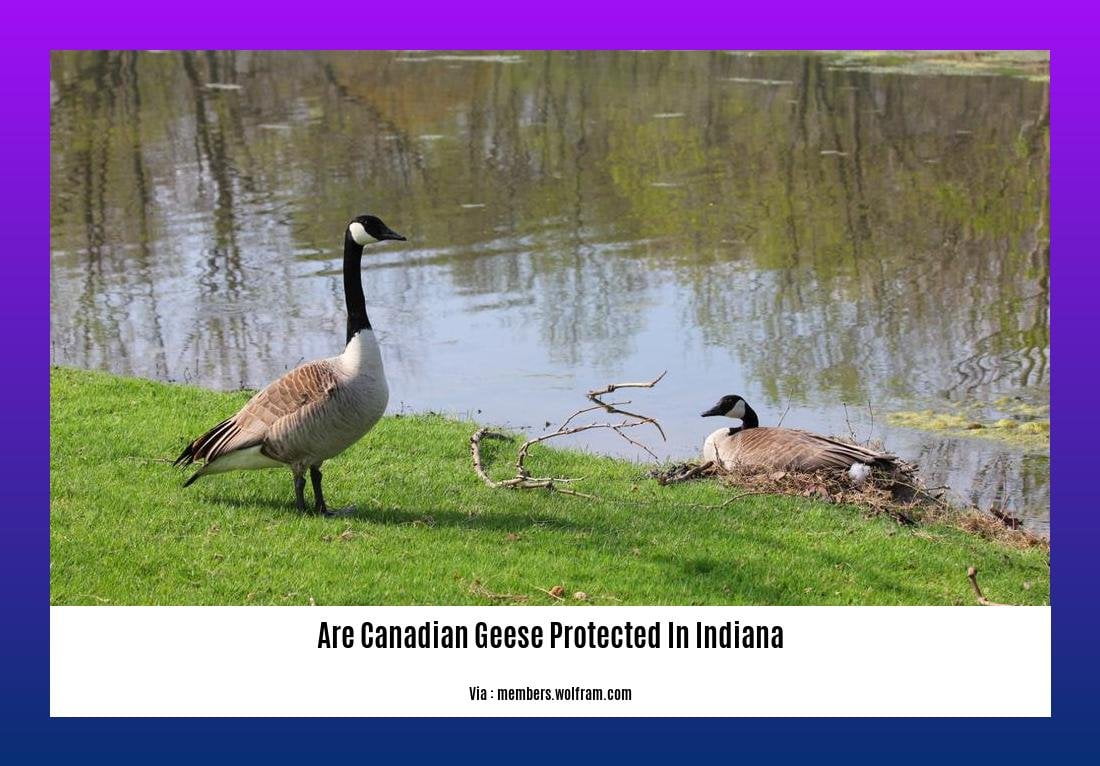
When it comes to sharing our environment with wildlife, understanding our responsibilities as individuals is crucial. In the case of Canadian geese, these magnificent creatures play an important role in our ecosystems, but their increasing presence in developed areas has led to conflicts and raised questions about coexistence. In this article, we will explore the responsibilities we have in co-existing with Canadian geese in Indiana, delving into the ecological significance of these birds and the challenges they present.
The Ecological Significance of Canadian Geese
Canadian geese, also known as Canada geese, were once decimated by hunting and habitat loss. However, conservation efforts have led to their recovery, and they are now a common sight in many communities. These birds are protected under the Federal Migratory Bird Treaty Act, which safeguards all migratory birds, including Canadian geese. This legal protection ensures that harming geese, their nests, or their eggs is illegal in Indiana and throughout the United States.
The Challenges of Co-existing with Canadian Geese
While the recovery of Canadian geese is a conservation success story, their increasing populations in developed areas can pose challenges. When geese are fed by people, they can congregate in small areas and exhibit aggressive behavior. Moreover, high goose populations in developed areas can lead to conflicts with humans, create risks of accidents with motor vehicles, and potentially spread diseases.
Understanding Our Responsibilities
To ensure a harmonious coexistence with Canadian geese, it is essential that we understand and uphold our responsibilities. While it may be tempting to feed these beautiful creatures, it is best to avoid doing so. Feeding geese only reinforces their association of humans with food and encourages them to remain in developed areas, exacerbating the challenges mentioned earlier.
Furthermore, devices and strategies aimed at controlling goose conflicts, such as noise makers or relocation efforts, may not provide long-term solutions. Instead, we need to prioritize understanding and respecting the natural behaviors of geese, as well as the regulations in place to protect them.
Taking Action: What You Can Do
Responsible Behavior: Be mindful of your actions around Canadian geese, avoiding the temptation to feed them. Remember that these birds are wild creatures and have their own natural sources of food.
Maintain Distance: Give geese their space and avoid approaching them or their nests. Respecting their habitat and boundaries helps reduce conflicts and stress.
Educate Others: Spread awareness about the challenges of co-existing with Canadian geese and the importance of responsible behavior. Inform your community, friends, and family about the ecological significance of these birds and the need to protect their habitats.
Support Conservation Efforts: Engage with local organizations and initiatives working towards the conservation of Canadian geese and their habitats. You can contribute by volunteering or donating to support their efforts.
Key Takeaways:
- Canadian geese are protected under the Federal Migratory Bird Treaty Act, making it illegal to harm the birds, their nests, or their eggs.
- Feeding geese can lead to aggressive behavior and an over-reliance on developed areas, intensifying conflicts and risks.
- Understanding natural behaviors and respecting the regulations in place is vital for a harmonious coexistence with Canadian geese.
- By practicing responsible behavior, maintaining distance, educating others, and supporting conservation efforts, we can contribute to the preservation of these magnificent birds and their habitats.
Sources:
- North Carolina Wildlife Resources Commission. “Co-Exist with Canada Geese.”
- The Humane Society of the United States. “Solving Problems with Canada Geese.”
Understanding the Legal Protection: Are Canadian Geese Protected in Indiana?
Have you ever wondered about the legal protection surrounding Canadian geese in Indiana? As an experienced wildlife journalist, I’m here to shed light on the importance of conservation efforts for the preservation of Canadian geese in Indiana. Let’s delve into the topic and explore the legal framework that safeguards these magnificent creatures.
Key Takeaways:
- Canada geese in Indiana are federally protected under the Migratory Bird Treaty Act of 1918 and can only be hunted during specified hunting seasons and within specific parameters.
- The population of Canada geese in Indiana has increased due to restoration efforts and the availability of small urban and suburban water bodies.
- Although Canada geese are not considered endangered by the International Union for Conservation of Nature (IUCN), they are classified as a species of least concern.
- Canada goose management aims to reduce conflicts rather than eliminate all geese, emphasizing organized plans with community support for successful outcomes.
Canada geese have become a familiar sight in Indiana, but what regulations ensure their protection? These majestic birds are federally protected under the Migratory Bird Treaty Act of 1918 (leicestershirevillages.com). This act restricts hunting of Canada geese to specific seasons and sets parameters to prevent overhunting and conserve their population.
The population of Canada geese in Indiana has seen a significant increase, thanks to restoration efforts and the availability of small water bodies in urban and suburban areas (in.gov). While they may not be considered endangered, according to the International Union for Conservation of Nature (IUCN), Canada geese are classified as a species of least concern (natureconservancy.ca). However, their protection is still crucial for maintaining the delicate balance of our natural ecosystems.
In Indiana, Canada goose management aims to reduce conflicts rather than eliminating all geese. This approach recognizes the ecological significance of these birds and the importance of coexisting with them in harmony. Plans that are organized with community buy-in and long-term commitment are more likely to succeed (in.gov).
It’s important to note that human-induced changes to the landscape have favored the rapid growth of the Canada goose population, particularly in heavily populated areas (canada.ca). This ubiquity is especially evident in Canadian cities, where the presence of Canada geese in urban landscapes has become commonplace (cbc.ca). However, it’s essential to ensure that everyone has equal opportunities to appreciate nature and wildlife, as people of color may face barriers to experiencing activities such as birdwatching (cbc.ca).
Canada geese also engage in seasonal migrations, including traveling to the United States during specific times of the year (animalsanswers.com). This necessitates a cooperative effort in conservation not only within individual states but also across borders.
In conclusion, understanding the legal protection granted to Canadian geese in Indiana is crucial for fostering coexistence and preserving these magnificent birds for future generations. By adhering to the regulations and supporting conservation efforts, we can ensure the continued beauty and ecological balance these geese bring to our state.
Sources:
– leicestershirevillages.com: Link
– in.gov: Link
FAQ
Q1: Are Canadian geese protected in Indiana?
A1: Yes, Canadian geese are protected in Indiana under the Migratory Bird Treaty Act of 1918. It is illegal to harm geese, and only individuals with a state-issued special license are permitted to shoot geese during the hunting season. Permits are available to shoot depredating geese outside of the normal hunting season.
Q2: What are the legal consequences of hitting a goose with a car in Indiana?
A2: Hitting a goose with a car is considered a serious offense in Indiana and is illegal. There may be legal consequences for causing harm to a protected species under the Migratory Bird Treaty Act of 1918.
Q3: Can I shoot domestic geese in Indiana?
A3: Domestic geese are not regulated by the Indiana Department of Natural Resources. However, if the domestic geese are actually Canada geese and causing depredation, permits may be issued for agricultural depredation and trapping activities.
Q4: What are the guidelines for shooting geese in Indiana?
A4: Shooting hours for geese and ducks in Indiana are from one-half hour before sunrise to sunset, except for teal season. During the hunting season, only individuals with a state-issued special license are permitted to shoot geese. Permits may also be available outside of the normal hunting season for shooting depredating geese.
Q5: What is the aim of Canada goose management in Indiana?
A5: The aim of Canada goose management in Indiana is to reduce the number of conflicts rather than eliminating all geese. Plans organized with community buy-in and time commitment are more likely to be successful in managing the population and reducing conflicts.
- Firebaugh-Las Deltas Unified School District: News, Information, and Resources - November 24, 2024
- Incinolet Toilets: A 2024 Buyer’s Guide to Waterless, Off-Grid Sanitation - November 24, 2024
- Is Periodontal Disease Contagious? What You Need to Know - November 24, 2024
